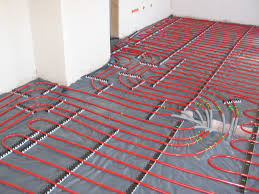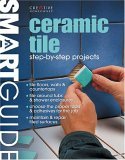Keep Your Ceramic Tiled Floor Cozy Warm with Radiant Heat
|
|
One of the negatives of installing a ceramic tile floor in a bathroom is how cold the tile can feel on your bare feet on a cold winter morning.
Fortunately there is a toasty warm solution to this problem. By installing radiant heat underneath the ceramic floor tile you can ensure your bathroom floor is warm and comfortable when you walk on it in the morning. Moreover, radiant heat rises upwards from the floor to provide a very evenly distributed heat throughout the entire bathroom. And surprising to many homeowners, installing radiant heat under ceramic floor tile is very affordable and fairly easy to do. |
There are two types of radiant heat systems available to you, hydronic and electric systems. The hydronic radiant heat system requires the installation of a serpentine network of plastic tubing, a boiler, manifold and pump system. With hydronic radiant heat systems warm water is pumped through the tubing to produce the radiant heat. Hydronic radiant heating systems are ideal for heating an entire home, however they are expensive to install due to all of the labor and mechanical equipment required.
When installing an electrical radiant heating system a separate 15 or 20 Amp Ground Fault Circuit Interrupter (GFCI) protected circuit will need to be wired into the main circuit panel. A licensed electrician should install this for you. After the electrical circuit has been established in the main circuit panel you can go about installing the electrical radiant heat system, of course with the circuit break turned off to the future radiant heat system.
| There are a number of electrical radiant heat manufacturers and systems you can choose from. Basically they all comprise of a mat or plastic slotted channels that are fastened to the subfloor, with the electrical heating wire installed into them. Often the mats or channels can be cut into various shapes and the electrical heating wire installed afterwards to satisfy any type of floor plan.
After the electrical radiant heat system has been installed onto the subfloor and has been wired up to the new GFCI circuit, the ceramic tile floor can then be installed. |
 |
Before installing the ceramic tile, however, it’s important to first read the electrical radiant heat system manufacturer’s recommendations on how to install the ceramic tile over the radiant heat system. Not all ceramic tile thinset mortars work well with radiant heat systems. In addition, the electrical radiant heat system needs to be protected against moisture problems. Typically a moisture membrane liner needs to be installed in between the radiant heat and the ceramic floor tile to prevent moisture penetration and corrosion issues.
So before you install a ceramic tiled floor in your bathroom or kitchen, check into including an electrical radiant heat system. Your family and your bare feet will be thanking you for years to come.
For information on installing a shower pan membrane liner for a ceramic tile shower, see the Shower Pan Membrane Liner Installation Ebook from HomeAdditionPlus.com. The Shower Pan Membrane Liner EBook will quickly teach you the step-by-step process for installing the shower pan membrane liner correctly. It includes instructions on framing the shower stall, pouring the pre-slope and shower base mortar, and installing the shower pan membrane liner.
See HomeAdditionPlus.com’s Ceramic Tile Calculator
See my “How to Tile a Custom Ceramic Tile Shower” Ebook to learn how to tile your own shower: For a detailed set of instructions on tiling a shower floor and walls, including pictures for every step in the process, see my “How to Tile Custom Ceramic Tile Shower Ebook”.
Related Information
- The Advantages of Slate Tile Floors
- The Importance of Underlayment When Tiling a Floor
- Ceramic Tile Subfloor Preparation
Additional Ceramic Tile Resources from Amazon.com
 |
 |
 |
Get Free Bathroom Remodeling Price Quotes with No Obligation!
Fill out our 3-5 minute quick and easy form, and receive a free price quote on a bathroom remodeling project from one of our pre-screened and licensed bathroom remodeling contractors. This process is free and there is no obligation to continue once you receive your bathroom addition price estimate.

